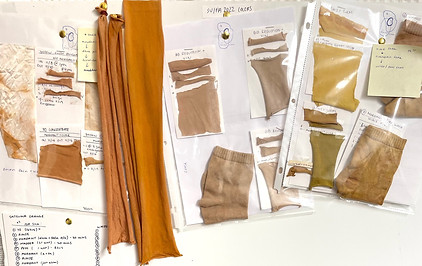MATERIALS / PRODUCTION
1. 100% COMPASSIONATE SILK
When we think quality + getting closer to nature, silk is the most ideal natural canvas. the process of producing it does not involve the harsh chemicals, pesticides, fertilizers (+ water usage) that cotton + synthetics require. That means less toxicity around the most sacred parts of your body. Beyond this, silk is naturally breathable, cooling + the strongest natural fiber. It doesn't take a lot of land or energy to produce and is naturally hypoallergenic.
*we use nonviolent (sometimes called ethical/ahimsa) silk because it’s important that we support nature through the entirety of her cycles + allow silk worms to emerge from their cocoons without harm before harvesting fibers.
2. EUCALYPTUS FIBER
Made from wood pulp of sustainably harvested trees + produced in a closed-loop process, meaning water is filtered + re-used. It takes far less heat, energy, chemicals + resources to make than other similarly biodegradable fibers, like viscose (bamboo) or cotton.
This is also the material of our sewing thread for every piece.
3. BIODEGRADABLE ELASTIC
For years we searched high + low for safely + fully biodegradable elastic, which didn’t readily exist on the market. there also weren't any other options that met our quality needs: buttery + luxurious on skin plus be able to hold up to the everyday job of supporting our beautiful bodies.
Our solve was to partner with the best in elastic to develop a 100% biodegradable band (we really can’t take credit for their science + expertise, but we’re so happy they said yes to trying)!
Our stretch fiber received a Gold Material Health Certificate from Cradle-to-Cradle Product Innovation Institute. More importantly however, it’s reached Hohenstein Environment Compatibility Certification, meaning it breaks down without releasing harmful substances into the environment; In active soil, the yarn is able to decompose to produce CO2 + water, becoming part of the continuous cycle of nature. Even better, it takes natural dyes well, saving water during the dye process. We’re so proud to have asked the right questions, found hard-working partners + been able to bring this dreamy material to you.
4. PLANT + LOW IMPACT DYES
We work with a local dye house here in LA that uses low impact dyes, which conserve water + energy
we also celebrate the colors of the earth through botanical dyes. that means no harmful chemicals. pigments come directly from plants like madder, pomegranate, indigo, turmeric + avocados. This also means that each dyed piece is fully unique.
we're working on some videos, events pages and guides on how to plant dye at home!




